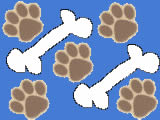How To Teach Attention
"He is your friend, your partner, your defender, your dog. You are his life,
his love, his leader. He will be yours, faithful and true, to the last beat
of his heart. You owe it to him to be worthy of such devotion." Unknown
Attention
Teaching your dog to be attentive is the number one most important skill in training a dog. Without your dogs attention, you will have difficulty in every other aspect of your dog training program. All bad dog behavior is rooted in where your dogs attention is focused. All problem solving dog training techniques require your dogs utmost attention. Having strong attention from your dog will make for easy dog training. Of all the dog training tips or dog training secrets that can be offered, this is the positive dog training solution.
ATTENTION
Use food to train your dog. I find that small pieces of soft treats work best, or you could mix small pieces of hot dog, cheese, or anything your dog likes to eat. Please train before you feed your dog his meal. You will have better success. Also, if you free-feed (leave food out all day) your dog may not have any desire to participate in these exercises. You should present 1-3 meals to your dog a day and if your dog doesn't finish the meal after 20 minutes, take the food away until the next meal. If they have a good training session, feed immediately afterward so the dog connects the training session with the feeding.
Practice 5-15 minutes at least once per day.
Secondary Reinforcer
The first step is to train a positive marker. Many things can be used as a marker. I use the word "Good" as my marker, but you can use a clicker, whistle, or any distinct noise. Even touch can be used as a marker. I like to use words because you can never lose your marker.
Say "Good," wait about a half second, then present your treat.
Repeat several times.
This half second delay should be increased to several seconds once your dog starts to focus on the task at hand. During this delay, watch your dog's reaction to see if your can see him swallow and lick his mouth because his mouth is filling up with saliva. (This is Pavlov's Law)
Your Dogs Name Is The Attention Command
- Call the dogs name using a consistent tone of voice.
- When the dog makes eye contact with you, praise enthusiastically with "good dog" and give him a treat.
- Walk away, and then repeat again.
If the dog ignores you, get up close and let him smell the treat, then proceed with calling his name and giving praise when he makes eye contact.
When the dog has mastered this exercise, advance to the next level.
- Call the dogs name while holding a treat.
- When he makes eye contact, praise him verbally, and gradually and slowly lower the treat toward you dog. Your goal is to increase the amount of time your dog maintains focus.
- Stop, give him the treat, praise verbally, and pet him.
Intense focus is the main goal with this exercise. It is this intense focus that will allow your dog to ignore any distractions and him.
The key to this kind of training is consistent praise for any positive response shown by the dog, whether it is in the form of a treat, verbally (good dog) or
physically (petting the dog).
It will take puppies a few weeks to respond reliably to these commands. Their attention span is short, so your training sessions should be short (start with 5 minutes) to keep their interest and receptiveness.
For older dogs, 10-15 minutes is usually adequate for training sessions.
Always end your training sessions on a positive note and with the puppy or dog completing the command correctly. Ending a session on a bad note may continue into the next training session. If you are having a day where things are not going as well as you'd like, choose a command that is easy and that you know the dog will do correctly. Praise the dog, release him and let him go play.
Remember, you are encouraging playful learning, not demanding obedience. Conduct your training sessions at home first and gradually introduce distractions and strange surroundings.






